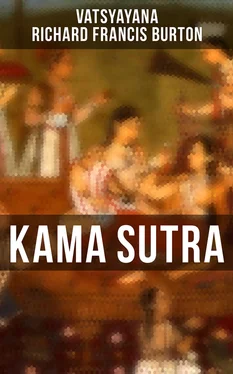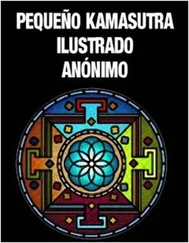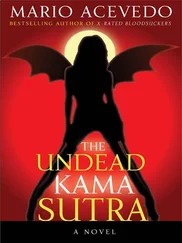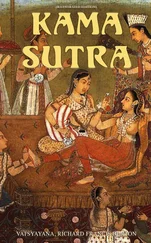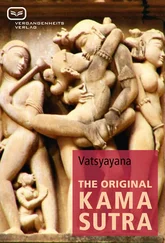The author of the 'Light of Love' (No. 3) was the poet Gunakara, the son of Vechapati. The work contains four hundred verses, and gives only a short account of the doctrines of love, dealing more with other matters.
'The Garland of Love' (No. 4) is the work of the famous poet Jayadeva, who said about himself that he is a writer on all subjects. This treatise is, however, very short, containing only one hundred and twenty-five verses.
The author of the 'Sprout of Love' (No. 5) was a poet called Bhanudatta. It appears from the last verse of the manuscript that he was a resident of the province of Tirhoot, the son of a Brahman named Ganeshwar, who was also a poet. The work, written in Sanscrit, gives the descriptions of different classes of men and women, their classes being made out from their age, description, conduct, etc. It contains three chapters, and its date is not known, and cannot be ascertained.
'The Stage of Love' (No. 6) was composed by the poet Kullianmull, for the amusement of Ladkhan, the son of Ahmed Lodi, the same Ladkhan being in some places spoken of as Ladana Mull, and in others as Ladanaballa. He is supposed to have been a relation or connection of the house of Lodi, which reigned in Hindostan from A.D. 1450-1526. The work would, therefore, have been written in the fifteenth or sixteenth century. It contains ten chapters, and has been translated into English, but only six copies were printed for private circulation. This is supposed to be the latest of the Sanscrit works on the subject, and the ideas in it were evidently taken from previous writings of the same nature.
The contents of these works are in themselves a literary curiosity. There are to be found both in Sanscrit poetry and in the Sanscrit drama a certain amount of poetical sentiment and romance, which have, in every country and in every language, thrown an immortal halo round the subject. But here it is treated in a plain, simple, matter of fact sort of way. Men and women are divided into classes and divisions in the same way that Buffon and other writers on natural history have classified and divided the animal world. As Venus was represented by the Greeks to stand forth as the type of the beauty of woman, so the Hindoos describe the Padmini or Lotus woman as the type of most perfect feminine excellence, as follows:
She in whom the following signs and symptoms appear is called a Padmini. Her face is pleasing as the full moon; her body, well clothed with flesh, is soft as the Shiras or mustard flower, her skin is fine, tender and fair as the yellow lotus, never dark coloured. Her eyes are bright and beautiful as the orbs of the fawn, well cut, and with reddish corners. Her bosom is hard, full and high; she has a good neck; her nose is straight and lovely, and three folds or wrinkles cross her middle—about the umbilical region. Her yoni resembles the opening lotus bud, and her love seed (Kama salila) is perfumed like the lily that has newly burst. She walks with swan-like gait, and her voice is low and musical as the note of the Kokila bird, she delights in white raiments, in fine jewels, and in rich dresses. She eats little, sleeps lightly, and being as respectful and religious as she is clever and courteous, she is us to worship the gods, and to enjoy the conversation of Brahmans. Such, then, is the Padmini or Lotus woman.
Detailed descriptions then follow of the Chitrini or Art woman; the Shankhini or Conch woman, and the Hastini or Elephant woman, their days of enjoyment, their various seats of passion, the manner in which they should be manipulated and treated in sexual intercourse, along with the characteristics of the men and women of the various countries in Hindostan. The details are so numerous, and the subjects so seriously dealt with, and at such length, that neither time nor space will permit of their being given here.

One work in the English language is somewhat similar to these works of the Hindoos. It is called 'Kalogynomia: or the Laws of Female Beauty,' being the elementary principles of that science, by T. Bell, M.D., with twenty-four plates, and printed in London in 1821. It treats of Beauty, of Love, of Sexual Intercourse, of the Laws regulating that Intercourse, of Monogamy and Polygamy, of Prostitution, of Infidelity, ending with a catalogue raisonnée of the defects of female beauty.
Other works in English also enter into great details of private and domestic life. 'The Elements of Social Science, or Physical, Sexual and Natural Religion,' by a Doctor of Medicine, London, 1880, and 'Every Woman's Book,' by Dr. Waters, 1826. To persons interested in the above subjects these works will be found to contain such details as have been seldom before published, and which ought to be thoroughly understood by all philanthropists and benefactors of society.
After a perusal of the Hindoo work, and of the English books above mentioned, the reader will understand the subject, at all events from a materialistic, realistic and practical point of view. If all science is founded more or less on a stratum of facts, there can be no harm in making known to mankind generally certain matters intimately connected with their private, domestic, and social life.
Alas! complete ignorance of them has unfortunately wrecked many a man and many a woman, while a little knowledge of a subject generally ignored by the masses would have enabled numbers of people to have understood many things which they believed to be quite incomprehensible, or which were not thought worthy of their consideration.
Table of Contents
It may be interesting to some persons to learn how it came about that Vatsyayana was first brought to light and translated into the English language. It happened thus. While translating with the pundits the 'Anunga runga, or the stage of love,' reference was frequently found to be made to one Vatsya. The sage Vatsya was of this opinion, or of that opinion. The sage Vatsya said this, and so on. Naturally questions were asked who the sage was, and the pundits replied that Vatsya was the author of the standard work on love in Sanscrit literature, that no Sanscrit library was complete without his work, and that it was most difficult now to obtain in its entire state. The copy of the manuscript obtained in Bombay was defective, and so the pundits wrote to Benares, Calcutta and Jeypoor for copies of the manuscript from Sanscrit libraries in those places. Copies having been obtained, they were then compared with each other, and with the aid of a Commentary called 'Jayamangla' a revised copy of the entire manuscript was prepared, and from this copy the English translation was made. The following is the certificate of the chief pundit:—
"The accompanying manuscript is corrected by me after comparing four different copies of the work. I had the assistance of a Commentary called 'Jayamangla' for correcting the portion in the first five parts, but found great difficulty in correcting the remaining portion, because, with the exception of one copy thereof which was tolerably correct, all the other copies I had were far too incorrect. However, I took that portion as correct in which the majority of the copies agreed with each other."
The 'Aphorisms on Love,' by Vatsyayana, contains about one thousand two hundred and fifty slokas or verses, and are divided into parts, parts into chapters, and chapters into paragraphs. The whole consists of seven parts, thirty-six chapters, and sixty-four paragraphs. Hardly anything is known about the author. His real name is supposed to be Mallinaga or Mrillana, Vatsyayana being his family name. At the close of the work this is what he writes about himself:
Читать дальше
